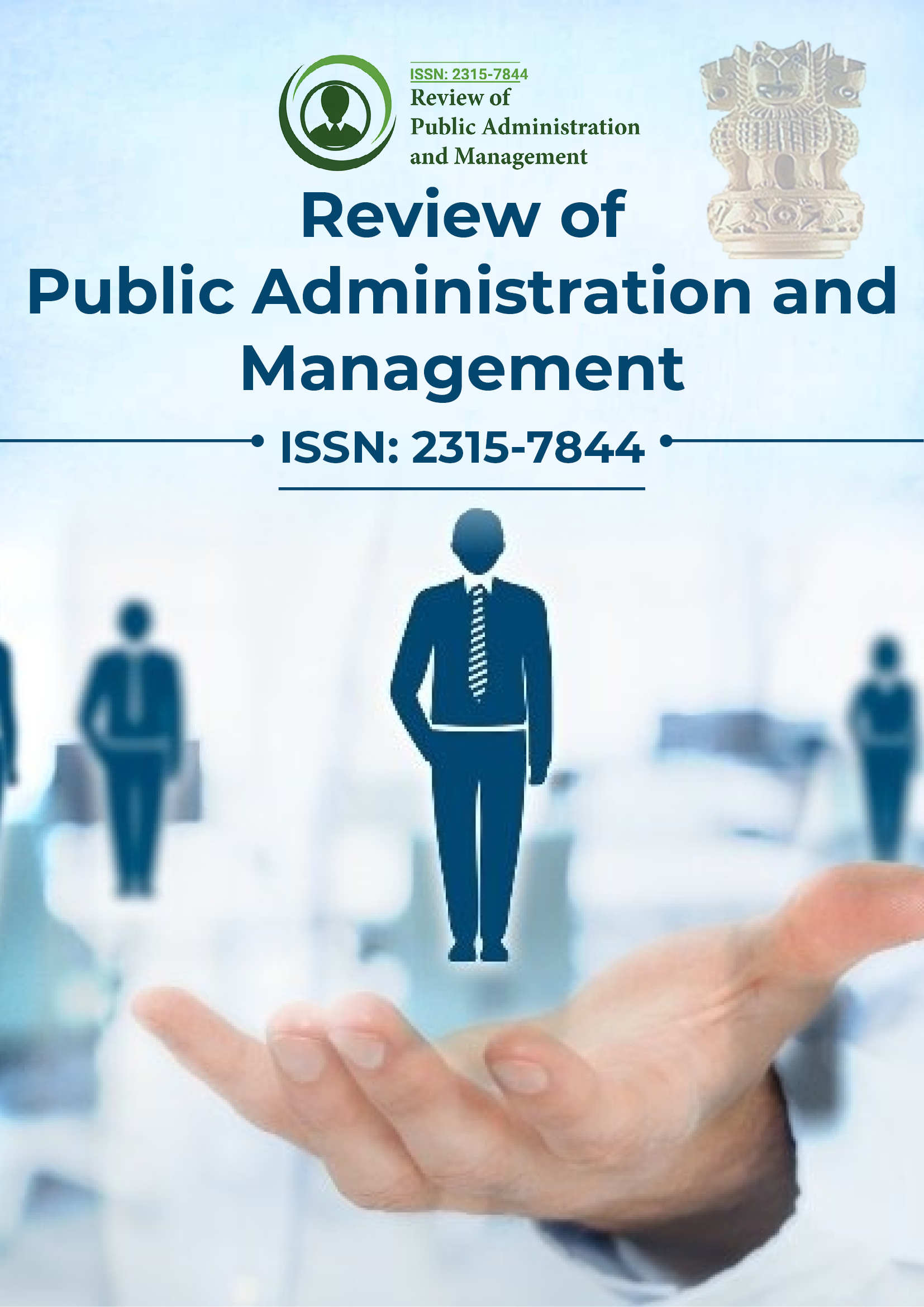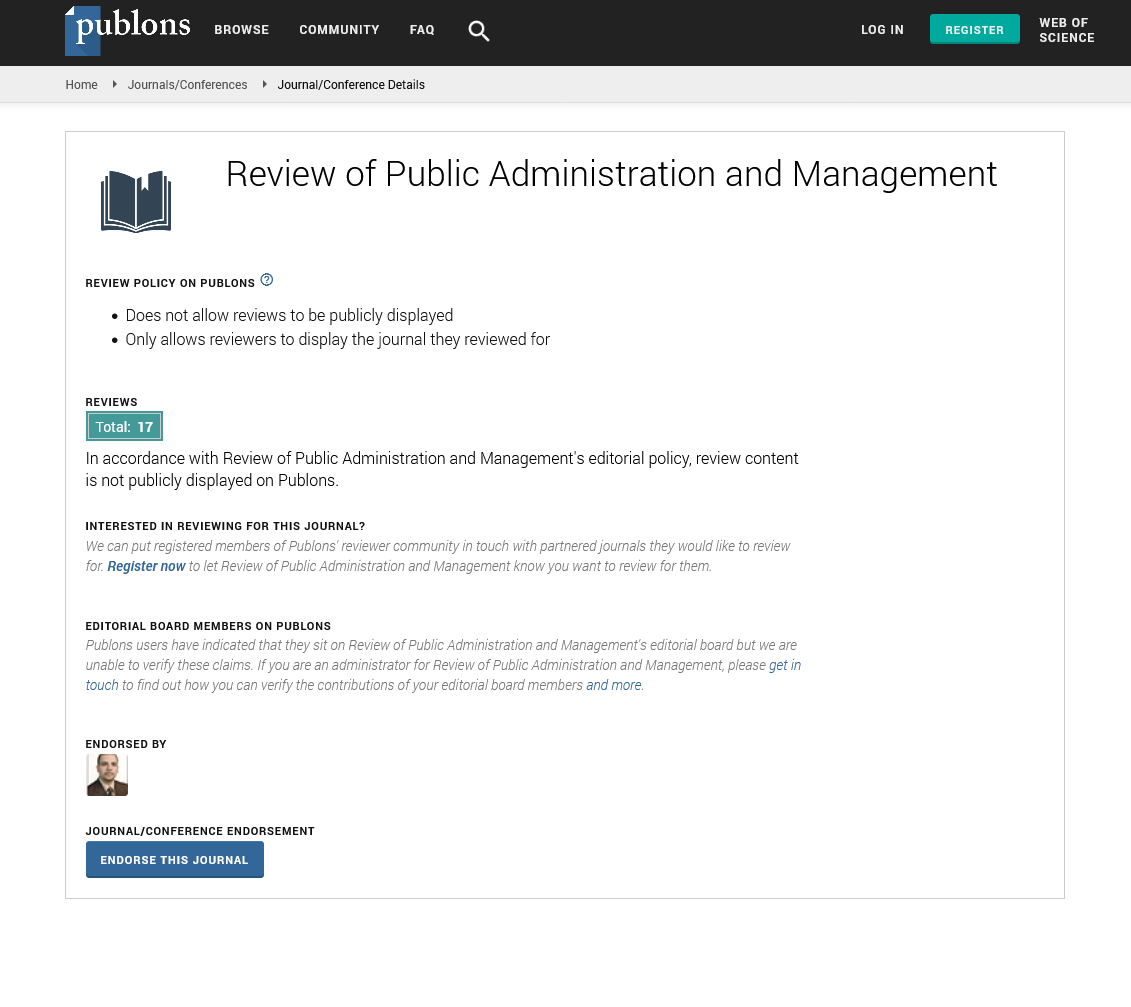Indexed In
- CiteFactor
- RefSeek
- Directory of Research Journal Indexing (DRJI)
- Hamdard University
- EBSCO A-Z
- Scholarsteer
- Publons
- Euro Pub
- Google Scholar
Useful Links
Share This Page
Journal Flyer

Open Access Journals
- Agri and Aquaculture
- Biochemistry
- Bioinformatics & Systems Biology
- Business & Management
- Chemistry
- Clinical Sciences
- Engineering
- Food & Nutrition
- General Science
- Genetics & Molecular Biology
- Immunology & Microbiology
- Medical Sciences
- Neuroscience & Psychology
- Nursing & Health Care
- Pharmaceutical Sciences
Perspective - (2025) Volume 13, Issue 2
The Role of Public Administration in Crisis Management
Lukas Schneider*Received: 02-Jun-2025, Manuscript No. RPAM-25-29758; Editor assigned: 04-Jun-2025, Pre QC No. RPAM-25-29758; Reviewed: 17-Jun-2025, QC No. RPAM-25-29758; Revised: 21-Jun-2025, Manuscript No. RPAM-25-29758; Published: 28-Jun-2025, DOI: 10.35248/2315-7844.25.13.494
Description
Public administration is often evaluated in routine circumstances where efficiency, fairness and consistency in service delivery are the primary expectations. However, it is during crises that the capacity and resilience of administrative institutions are tested most severely. Crises such as natural disasters, pandemics, terrorist attacks and economic shocks create pressures that demand rapid decisions, coordination across agencies and effective communication with citizens. The ability of public administration to manage these challenges determines not only immediate outcomes but also long-term public trust in government. Crisis management involves four interrelated phases: preparedness, response, recovery and mitigation. Preparedness refers to planning and developing systems before a crisis occurs. Response involves immediate actions to protect lives and property. Recovery focuses on restoring normalcy and rebuilding communities, while mitigation aims at reducing risks for future events. Public administration plays a central role in all these phases, ensuring that plans are comprehensive, responses coordinated, recovery inclusive and mitigation informed by lessons learned.
The COVID-19 pandemic highlighted the strengths and weaknesses of administrative systems worldwide. In Germany, federal and state governments shared responsibilities, which allowed for local flexibility but also created coordination challenges. Some states moved faster in implementing testing and vaccination centers, while others lagged. The crisis revealed the importance of intergovernmental coordination and the risks of fragmented responses. At the same time, it demonstrated the capacity of administrations to mobilize resources rapidly. Temporary hospitals, digital contact tracing systems and financial support programs were rolled out within weeks, actions that would have seemed impossible under normal bureaucratic timelines. Preparedness is often underestimated until disaster strikes. Administrations that invest in contingency planning and regular drills tend to fare better when crises occur. Japan, for example, has long prioritized disaster preparedness due to its vulnerability to earthquakes and tsunamis. Public officials conduct annual drills involving schools, businesses and community groups, ensuring that citizens know evacuation procedures and that institutions are ready to respond. These preparations save lives when disasters occur. By contrast, administrations that neglect preparedness face higher casualties and economic losses, as seen in cases where flood management systems were poorly maintained or pandemic stockpiles neglected.
Communication is another critical component of crisis management. Crises often generate uncertainty and misinformation. Public administrations must therefore provide clear, accurate and timely information to prevent panic and guide behavior. During the COVID-19 crisis, countries that held daily briefings, shared transparent data and explained policies in plain language saw higher compliance with health measures. In contrast, inconsistent or confusing messages undermined trust and led to non-compliance. Effective communication requires not only information dissemination but also listening to citizen concerns. Hotlines, online platforms and community meetings allow feedback and questions, ensuring that policies are responsive to public needs. Resource allocation during crises tests administrative flexibility. Governments must quickly redirect funds, personnel and infrastructure to address urgent needs. This often means suspending routine operations or reallocating budgets. For example, during major floods in Germany, local administrations converted schools into temporary shelters and reassigned public employees to relief operations. Such adaptability reflects the capacity of administrations to act creatively under pressure. However, resource allocation is also political. Choices about who receives aid first or which regions are prioritized can generate tensions if not handled equitably. Transparency in decision-making and inclusive distribution mechanisms are essential to maintain fairness.
International cooperation has also become increasingly important in crisis management. Natural disasters and pandemics do not respect national borders. Administrations must therefore collaborate with international organizations, neighboring countries and non-governmental actors. The European Union, for instance, coordinated vaccine procurement for member states to ensure equitable distribution. Similarly, international aid agencies provide support during large-scale disasters in developing countries. Public administration’s role in managing these partnerships is crucial to ensuring efficiency and accountability in the use of external resources. Recovery is a long and complex process. Public administration must balance speed with thoroughness in rebuilding infrastructure, restoring services and addressing social impacts. Recovery policies that focus only on physical reconstruction risk ignoring psychological, cultural and economic dimensions. For instance, after the 2011 tsunami in Japan, administrators not only rebuilt housing but also provided counseling services, revived local industries and supported community festivals to restore social cohesion. Recovery therefore requires a holistic approach that integrates physical, social and emotional well-being.
Mitigation closes the loop of crisis management by reducing the risk of future events. Public administration learns from past crises by evaluating what worked and what failed. Lessons are incorporated into updated policies, training programs and infrastructure investments. For example, after severe flooding events, German municipalities invested in improved drainage systems and better land-use planning to reduce vulnerability. Similarly, global health administrations revised stockpiling and monitoring systems after COVID-19. Mitigation illustrates the importance of institutional memory in building resilience. Critics often highlight bureaucratic rigidity as an obstacle in crisis management. Traditional administrative procedures, designed for stability and accountability, can slow down rapid responses. To overcome this, some administrations adopt emergency powers or streamlined processes during crises. However, this raises concerns about accountability and potential abuse of power. Striking a balance between flexibility and accountability is therefore essential. Oversight mechanisms must remain active, even during emergencies, to prevent misuse of authority.
Citation: Schneider L (2025). The Role of Public Administration in Crisis Management. 13:494.
Copyright: © 2025 Schneider L. This is an open-access article distributed under the terms of the Creative Commons Attribution License, which permits unrestricted use, distribution and reproduction in any medium, provided the original author and source are credited.


